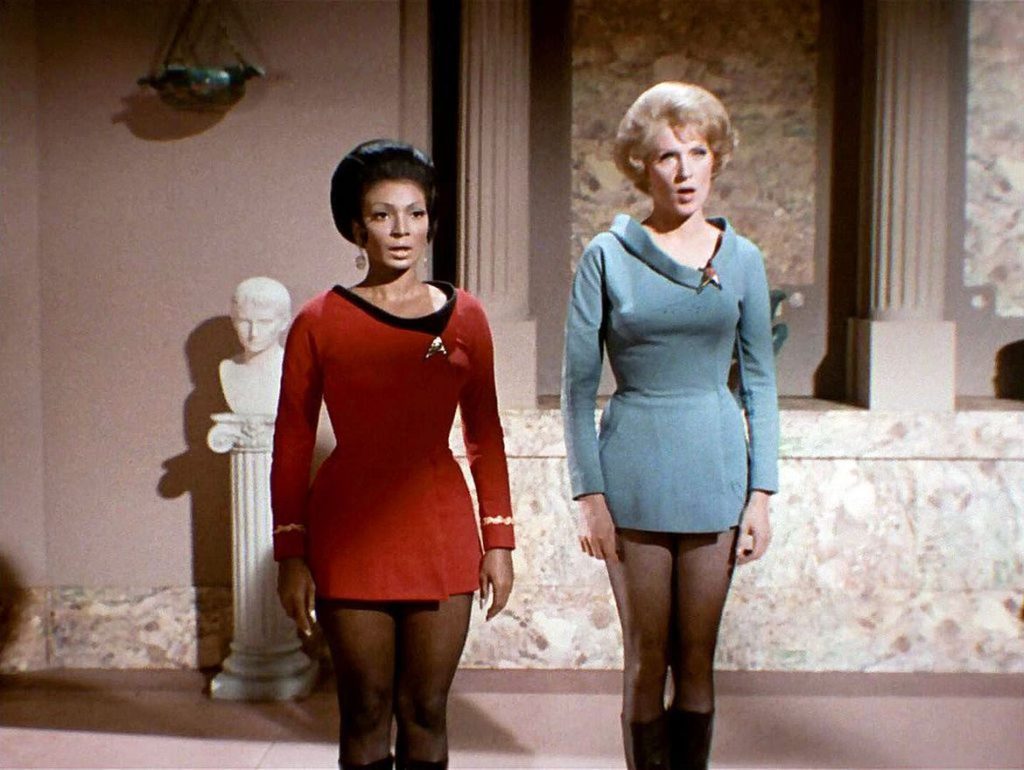“Star Trek” has been a cultural phenomenon for over 50 years and there’s no sign of it stopping. A brand new prequel series, “Star Trek: Strange New Worlds,” is set to be released in the near future. The franchise has millions of hardcore fans around the world and there are dozens of Star Trek memes, some of which are instantly recognizable. But the one that started it all is the original series, which aired from 1966 to 1969. The series inspired numerous sci-fi shows like “Babylon 5” and Farscape.
The original series was a truly groundbreaking endeavor in terms of story and themes. One reason it’s praised is by portraying an egalitarian future where everyone, regardless of creed, sex or race is respected. The women of “Star Trek” were pioneers in-universe and in television. But for all the applause, was “Star Trek” truly progressive? Today, let’s take a closer look at the women of “Star Trek: The Original Series” and some of the most memorable female characters, such as Nyota Uhura.
The Women of the Enterprise

The original series was years ahead in terms of casting and storylines. One of the main reasons the original series is so beloved and lauded is the inclusion of Lieutenant Nyota Uhura. Uhura is one of the first Black females on television to have a major role in television who wasn’t in some form of menial labor. What’s more, the show did not shy away from portraying her African heritage. Uhura is of Bantu-descent and speaks fluent Swahili. Uhura’s storylines and characterization emphasized her wits, dedication to duty and loyalty.
The character became one of the most cherished Black characters of all time. Actor Nichelle Nichols actually wanted to step down from the role after the first season but was convinced not to by none other than Marin Luther King Jr. himself. Nyota Uhura became role model for many women of color, a professional Black woman who boldly went where no woman had gone before. Her characterization was so influential, Star Trek’s Guinan, was inspired by her.
Aside from Nyota Uhura, an oft disregarded female character is Christine Chape, a nurse who frequently assisted Dr. Bones. The character was not very well received due to her poor storylines, which usually involved her frustrated love life. Her attraction to Spock, the logical and stoic science officer, was seen as a shoehorned attempt to highlight his coldness, to the detriment of her character’s portrayal.
It’s impossible to compare the importance of either of these women but there are stark differences. Uhura is presented more as her own person, with several plots highlighting her personal motivations and adventures. Chapel acts as more of an auxiliary character, either assisting Bones or pining after Spock. Although Chapel was promoted to doctor later on, she was still very underdeveloped compared to Uhura.
Women Across the Galaxy

The women of “Star Trek” aren’t restricted to the confines of starships. During their travels, Captain Kirk and his crew have encountered plenty of other women. They do share certain stereotypes. Any woman encountered in the original series tend to either be femme fatales or pure and moralistic.
Prime examples of femme fatales in the show include the sensitive murderess Lenore Caridian, the manipulative witch Sylvia and the brain stealing Kaara. All these female characters were remorseless in their machinations, but beautiful to behold. Although they had motivations, few could be considered particularly deep or well-rounded as characters.
On the opposite side of the scale are the pure and moralistic women. They often draw the attractions of Captain Kirk, a man whose intimate approach to sci-fi exploration and diplomacy is the stuff of countless Star Trek memes. These women are pure and chaste and idealistic. If they do wrong, they’re often misguided or coerced. This dichotomy is a side-effect of the Madonna/Whore complex, a sexist concept that shoehorns women into either amoral temptresses or virginal objects of attraction.
But whether they’re temptresses or Madonnas, a lot of these women are often shot through soft focus, also known as “Kirk’s Gaze.” This camera technique, achieved by smearing Vaseline on the lens, softens the features and makes women look more vulnerable. This reveals that for all the progressiveness of the show, it still catered to dated concepts of femininity.
Despite the shallow portrayals of many of the women who only appear in single episodes, the show still did well in portraying the women aboard the Enterprise. Nyota Uhura is shown to have desires but also morals, flaws but also ideals. She is a well-rounded and fully developed character.
While a lot of the issues regarding representations of women can be ascribed to the social consciousness of the time, the women of “Star Trek” are still role models in many ways. Although after 50 years, viewing them requires a more critical lens, Star Trek’s Guinan and Nyota Uhura can still inspire and showcase how great writing is the key to compelling female characters.





